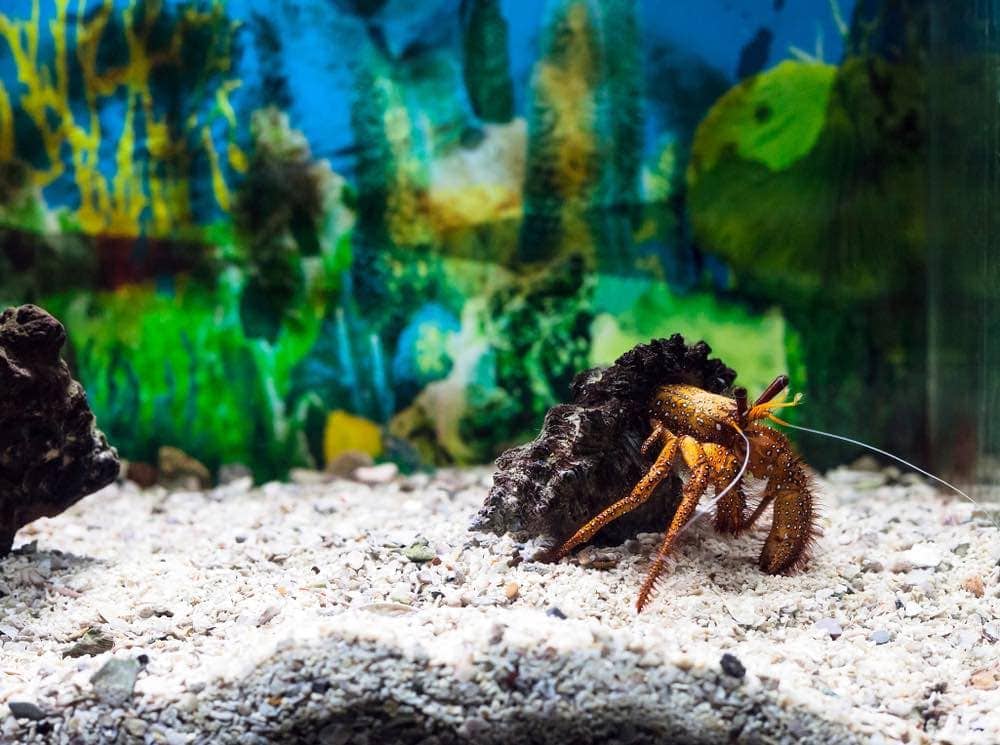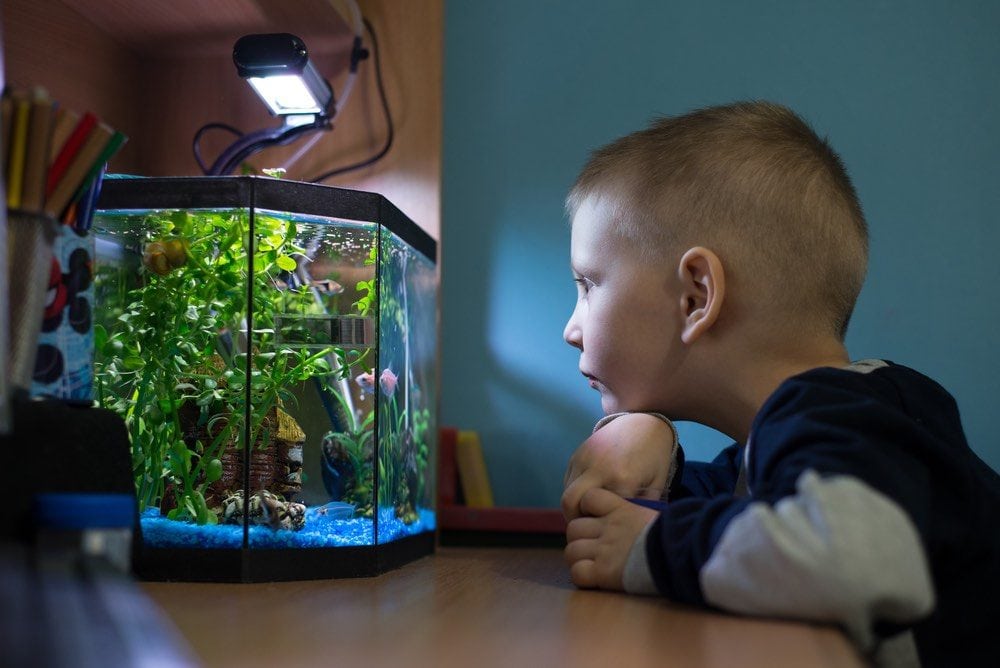Algae Eating Shrimp: Tank Mates, Care Tips & FAQs

Updated on
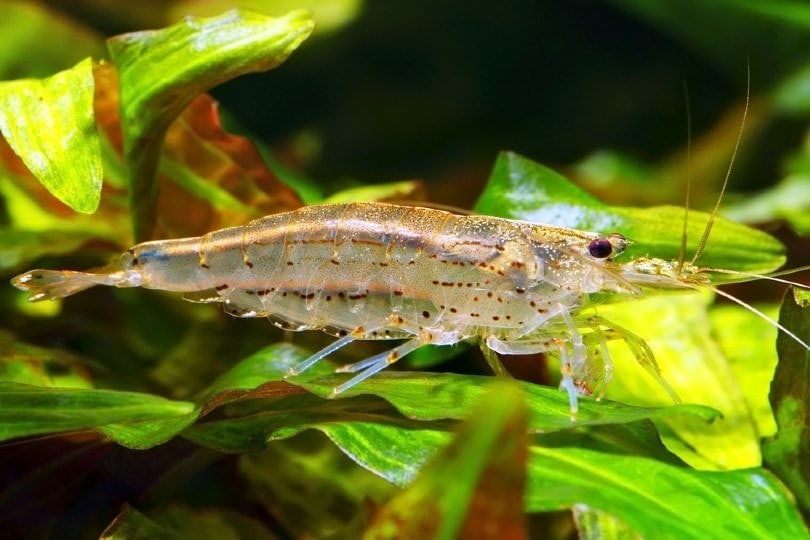
Algae eating shrimp are an absolutely fantastic thing to have in your aquarium because they greatly reduce the need for filtration and algae control. Fresh water shrimp have not been used for a very long time in the U.S.A, but thanks to their voracious algae-eating appetite, they are quickly become very popular among aquarium owners everywhere.
Before we dive into our top 3, let’s quickly cover some important points about shrimp, why they are a great and helpful addition to any aquarium. For anyone in a rush, amano shrimp are one of the most effective algae eaters.

About Aquarium Shrimp
Shrimp are technically classified as crustaceans, which means they are sea-dwelling creatures with a hard outer or exoskeleton.
Crabs and lobsters are also crustaceans. Shrimps feature two separate pairs of antennae on their heads and they also have branched appendages that work kind of like the mandibles on a spider.
Shrimp are also defined as decapods, which means that they have 10 legs organized into 5 distinct pairs. They usually have a front pair of legs which grow into pincers and those are called chelipeds.
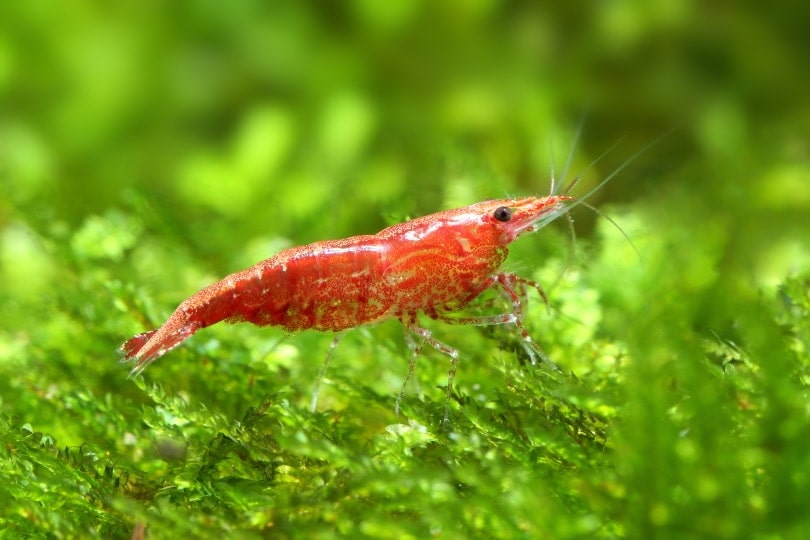
Do Shrimp Eat Algae?
Shrimp love to eat algae, and that is especially true for the smaller fresh water shrimp which are now often used in aquariums.
Before adding any shrimp to your tank, consider how temperamental and territorial the fish in your tank are, because after all , you don’t want to buy the shrimp just to have them be eaten by the other inhabitants in the tank.
Large, more territorial, and more aggressive fish will most likely end up eating smaller shrimp. While these shrimp love to eat algae, if there is not enough algae available, you will need to get special shrimp food for them, or else they will die of hunger.
The 3 Best Algae Eating Shrimp
There are various different shrimp which you can add to your aquarium which will be very beneficial in terms of eating algae. Here are some of the best shrimp to add to your tank.
1. Ghost Shrimp
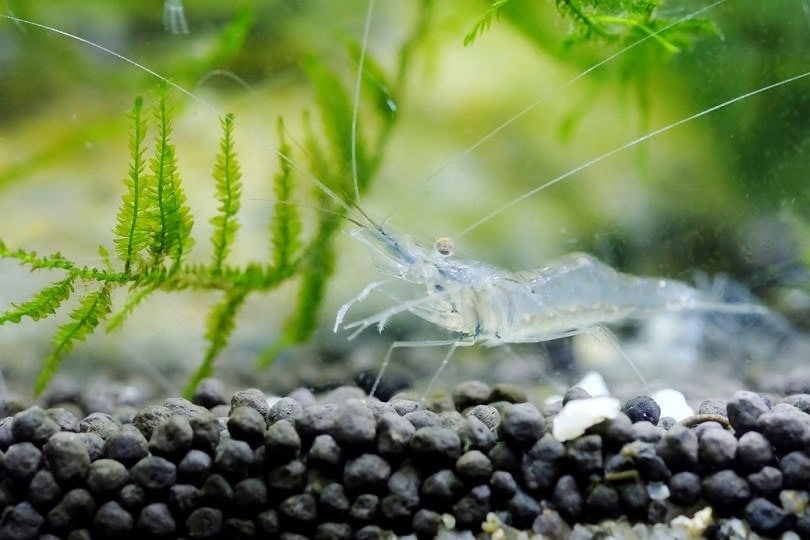
This is one of the first types of shrimp that aquarists began adding to their tanks, especially in North America. One of the biggest reasons for this is because they are readily available, can be bought as fish food, and they are a good addition for most aquariums (you can buy them at Amazon here). These shrimp are sometimes referred to as glass shrimp or grass shrimp. In fact, besides being algae controllers, their most common use is to feed bigger fish.
These fish are clear in nature and are very transparent. They need to be transparent when you buy them. Never buy ghost shrimp which are cloudy or milky as that indicates disease. They are great for controlling algae because they love to eat hair algae. Moreover, they are also very easy to breed in virtually any aquarium.
The females actually carry the eggs in their abdomen like crayfish and then release them when they are ready to be born. These shrimp are very small and do often get eaten by fish. Therefore, to make sure that your aquarium always has some ghost shrimp in it, you should always isolate the female which has eggs in order to ensure that some shrimp fry survive.
They have a much better chance of surviving in a heavily planted tank where there is room for the mature shrimp and the shrimp fry to hide in, under, and between plants.
Do Ghost Shrimp Eat Algae?
Not only do these things love to eat hair algae, but they also love to scavenge for old fish food and may even eat dead fish.
These things have been known to eat fish eggs and injured or dying fish, but that is not a problem that occurs all too often.
2. Red Cherry Shrimp
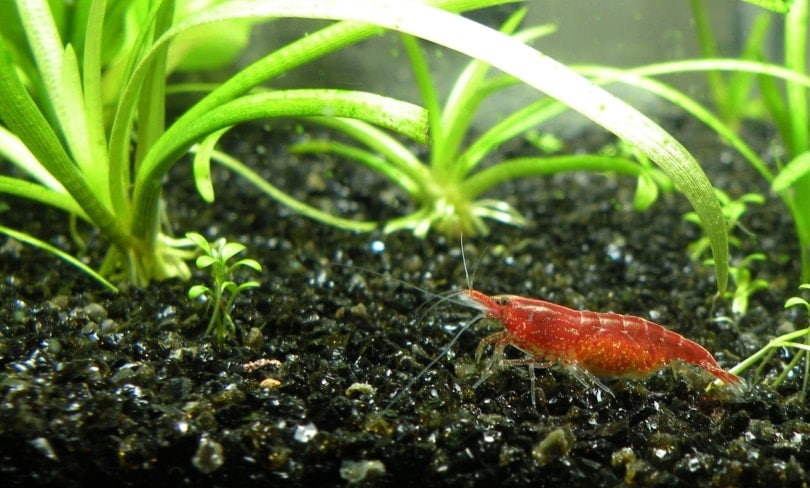
These are extremely tiny shrimp and their technical name is Neocaridina Denticulata Sinensis. They are quickly becoming some of the most popular algae eating aquarium shrimp around.
What is quite interesting to note is that their color does vary depending on age, sex, and health condition, the female red cherry shrimp is the one that is most brightly colored, as opposed to other animals where the male is usually the really colorful one.
What is convenient about these shrimp is that they also breed by keeping their eggs in the abdomen until they are big enough to look after themselves, which is when the mother releases them, just like the ghost shrimp.
These things are very easy to breed, but their small size, especially when it comes to the offspring, does make them a favorite food for many fish.
So, if you want to make sure that you always have a healthy population of red cherry shrimp in your aquarium, it is wise to keep some of the breeding adults in a separate space away from potential predators.
Because of their small size, you should really only house the red cherry shrimp with small and non-aggressive fish.
Do Cherry Shrimp Eat Algae?
Yes, these things like to eat a large variety of algae (and other things which we cover on this post) and therefore make for a great algae controlling animal to have in your aquarium.
3. Amano Shrimp OR Japanese Algae Eater Shrimp
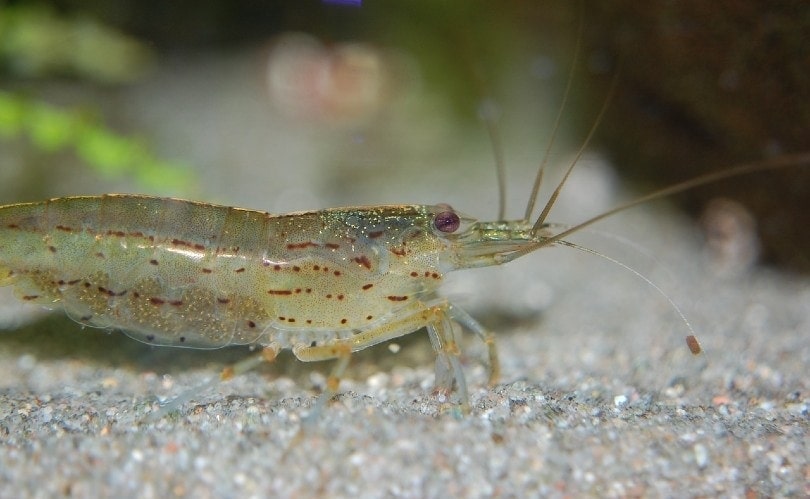
The amano shrimp is also known as the Caridina Japonica or Japanese algae eating shrimp. These things were not readily available in North America until quite recently.
You can however easily find them online or in specialty aquarium stores. They are still not quite as easy to find as the ghost or red cherry shrimp.
The amano shrimp likes to eat virtually all kinds of algae and they are very voracious eaters at that which is why they are often referred to as ‘Amano algae eating shrimp’.
They will however also eat decaying fish and fish food, so if there is too much fish food available they probably won’t eat as much algae as they usually would. The problem with these shrimp is that breeding them is very hard.
Now, getting the mother to carry eggs is not hard, but what is hard is getting the fry to survive. In nature, the fry will be carried away by ocean currents, away from the mother, where they grow up in brackish waters, plus they eat different food too.
Once they are mature they will then often migrate back to fresh water areas where they were first born.
What this means is that upon birth, you need to separate the amano shrimp fry from their mothers, feed them special food, and keep them in brackish waters.
Once they take on their adult form you can then transfer them back into freshwater. These are however in all reality the best type of algae eating shrimp to have.
Once fully matured they can handle a variety of water temperatures, they don’t care much about pH levels, and lighting is not too important either. In other words, they are very resilient towards changing aquarium conditions.
Amano Shrimp vs Ghost Shrimp: Which Is Better?
For those of you that are not quite sure whether you would like to have Amano shrimp or ghost shrimp, let’s take a quick look at what sets them apart.
Maybe we can help you come to a final decision here. Who knows, you might just end up wanting both.
- Readily available at most pet fish stores.
- Fairly inexpensive.
- Extremely easy to breed in most aquariums.
- Voracious eaters of hair algae.
- Will eat decaying fish and old fish food.
- Small and quite fragile – will get eaten by bigger fish.
- Do not require much maintenance or feeding.
- If breeding, isolate the female to ensure egg survival.
- Available at specialty stores (usually online).
- A little pricey.
- Will eat virtually any kind of algae.
- Will eat old fish food and dead fish.
- Breeding these shrimp is extremely hard.
- Require special care, feeding, and maintenance.
The Verdict
As you can see, ghost shrimp are generally less expensive and easier to care for, but it also doesn’t do the best job at taking care of algae.
On the other hand, Amano shrimp are more expensive, harder to find, harder to care for, and harder to breed, yet they do a much better job at eating all kinds of algae so in our opinion Amano’s are the better option.
Amano Shrimp Tank Mates
These guys can actually be quite lively and have been known to be thieves when it comes to food. That being said, you need to know what kind of fish you can house with them if you plan on building a community tank.
Let’s talk about some Amano Shrimp tank mates and what animals you should not house with them.
Good Tank Mates For Amano
Any kind of small or mid-size fish that is not aggressive, and preferable swims in the middle or top of the aquarium, will do just fine with Amano shrimp. Some of the best tank mates for these guys include:
- Cory catfish.
- Ottos.
- Platies.
- Nerite snails.
- Malaysian trumpet snails.
- Golden Inca snails.
- Ramshorn snails.
- Bamboo shrimp.
- Cherry shrimp.
- Vampire shrimp.
- Ghost shrimp.
Bad Amano Tank Mates
There are some animals which you should not house Amano shrimp with, mainly larger and more aggressive fish. Here are some Amano shrimp tank mates to avoid.
- Goldfish.
- Cichlids.
- Betta Fish.
- Roughens.
- Crayfish.
- Lobsters.
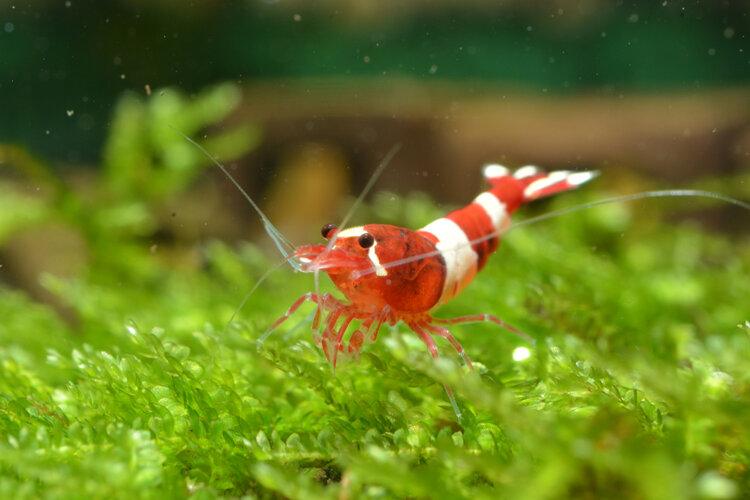
Shrimp Care Tips – Getting Started
In order to make the most out of your aquarium shrimp, there are a few things which you need to know.
When you first get the shrimp, open the box and remove the bag with the shrimp, and open the bag to let your shrimp get some fresh air. Fill a holding pail such as a bucket or glass with conditioned tap water.
To get your shrimp acclimatized to the aquarium, float the shrimp bag in the holding pail, then remove about ¼ of the water in the bag and replace it with the conditioned water from the holding pail.
Keep repeating this procedure every 15 minutes until the bag is completely filled with water from the holding pail. Finally, completely remove the shrimp form the bag with a net and place them in the holding pail.
Furthermore, the aquarium should be set up at least 2 weeks prior to introducing the shrimp into it. It should have diffuse light, yet it should not be in direct sunlight.
Moreover, the shrimp are going to require fairly constant water temperatures between 64 and 76 degrees Fahrenheit.
You really don’t want the shrimp’s water to be in direct sunlight, because the temperature changes from day to night can stress and kill them. Shrimp are also susceptible to rapid pH changes and toxin buildup, so just make sure to check pH levels and keep it constant, and make sure to change water often and keep it well filtered. (more on pH levels here).
Remember that to make the most out of your shrimp, you really should not feed them anything except for the algae already growing in the tank. If you feed them too much food, more than likely they will not end up eating very much algae, thus defeating their intended purpose.
Also, keep in mind that you really do want medium-sized shrimp. Shrimp that are too small will often be eaten by large fish, and very large shrimp can actually eat smaller fish, both things which you obviously don’t want.
FAQs
Amano Shrimp vs Cherry Shrimp: Differences?
One difference to keep in mind here is that when it comes to algae eating shrimp, amano shrimp tend to do a much better job at cleaning up algae than red cherry shrimp.
Another difference is that amano shrimp do cost a bit more than cherry shrimp. Yet another difference is that red cherry shrimp tend to breed freely within fish tanks, whereas amano shrimp do not.
Something else to keep in mind is that cherry shrimp will top out at around 1.5 inches in length, plus they feature a fairly bright red coloration, whereas amano shrimp can grow upwards of 2 inches and are more of a white/grey color.
The other difference to think about is that cherry shrimp usually will not live longer than 2 years, whereas amano shrimp can live for up to 3 years,
How Long Do Algae Eating Shrimp Live?
Well, as discussed above, an amano shrimp will live for about 3 years and a cherry shrimp will live for about 2 years, and yes, both of these shrimp eat algae.
When it comes to algae shrimp, another kind which likes to snack on algae is the ghost shrimp, however they usually only live for up to 1 year.
Snowball shrimp will also eat algae, and will usually live for between 1 and 2 years. There are of course other types of shrimp that eat algae, and for the most part, none will live past 3 years, with the vast majority of them topping out at 2 years of age.
Do Blue Shrimp Eat Algae?
Yes, blue shrimp will eat algae, although not all forms of it.
If there is some normal algae in your aquarium, they will eat some of it, although they are not the most voracious algae eaters out there.
They like to eat all sorts of meats, vegetables, and various types of fish food too.

Can You Put Amano Shrimp With Cherry Shrimp?
Yes, for the most part, as long as you have enough room to sustain both types of shrimp, you should be fine.
Both cherry shrimp and amano shrimp should be kept in groups of at least 5, so if you want to keep both types together, you do need a good size tank.
Moreover, both types of shrimp are fairly peaceful, non-aggressive, and can tolerate the same water conditions, so you should be able to keep them together just fine.
How Many Ghost Shrimp Can You Have In A 5 Gallon Tank?
Ghost shrimp are ideal aquarium animals, especially to keep with fish, as they do not require a whole lot of space.
Now, the general minimum tank size for ghost shrimp is 5 gallons, but do remember that they need to be kept in groups.
The rule of thumb here is to keep no more than 4 ghost shrimp per gallon of water, which means that you can have up to 20 of them in a 5 gallon tank.
However, do keep in mind that this is without other fish. If you have other fish in the tank as well, this number is of course less, but that said, the ghost shrimp is one of the best shrimp for algae control out there.
Final Thoughts
As long as you follow all of our care tips, there really should not be a problem in terms of maintaining a large and healthy population of shrimp. Furthermore, it is wise to get 1 of the 3 types of shrimp which we mentioned above, as they are in our opinion by far the best algae eating shrimp out there.
Related Reads:
- What Do Brine Shrimps Eat? Everything You Need to Know!
- 7 Tips to Get Rid of Red Algae in a Saltwater Tank: Causes & FAQs
Featured Image Credit: Grigorev Mikhail, Shutterstock





